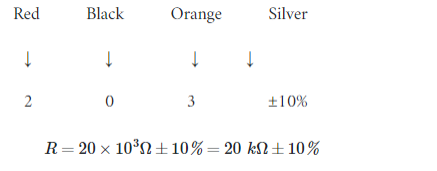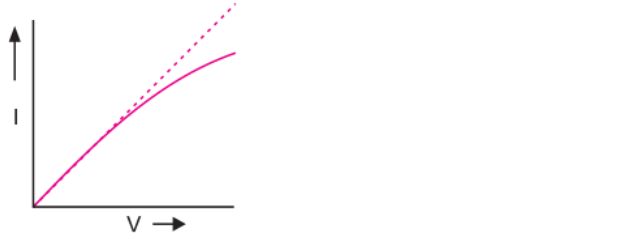Other Important Questions – Chapter 3 Current Electricity -Important 1 Mark Questions Class 12 CBSE Physics
Q. 1. Though we specify the direction of direct current by putting an arrow, why is it not considered a vector quantity?
Ans. Current is a scalar quantity because it does not obey the laws of vector addition.
Q. 2. Is current density a scalar or a vector quantity?
Ans. Current density is a vector quantity.
Q. 3. A steady current is flowing in a cylindrical conductor. Does electric field exist within the conductor?
Ans. Yes, electric field exists within the conductor because it is the electric field which imparts acceleration to electrons for the flow of current.
Q. 4. When a straight wire of resistance R is bent into U-shape, does its resistance change?
Ans. No, the resistance remains same, because length and cross-sectional area of the wire remain unchanged.
Q. 5. If the radius of a copper wire is doubled, will its specific resistance increase, decrease or remain same?
Ans. The specific resistance of a wire depends only on the material (at a given temperature). Therefore by changing the radius, the specific resistance of copper remains unchanged.
Q. 6. What is the effect of heating of a conductor on the drift velocity of free electrons?
Ans. Vd = eE𝜏 / m
By heating a conductor, the collisions of electrons occur more frequently; so relaxation time decreases and hence drift velocity decreases.
Q. 7. A uniform wire of resistance 50 Ω is cut into 5 equal parts. These parts are now connected in parallel. What is the value of equivalent resistance of the combination?
Ans. 2 ohms
Q. 8. What happens to the power dissipation if the value of electric current passing through a conductor of constant resistance is doubled?
Ans. P = I2RT
Clearly if current is doubled, the power dissipated becomes 4 times.
Q. 9. Define the term resistivity and write the SI unit.
Ans. The resistivity of a material of a conductor is defined as the resistance offered by a conductor of length 1 m and area of cross-section 1 m2. Its SI unit is ohm × metre (Ω m).
Q. 10. A carbon resistor is marked in colour bands of red, black, orange and silver. What is the resistance and tolerance value of the resistor?
Ans. From colour-code table

Q. 11. A wire of resistivity ρ is stretched to double its length. What will be its new resistivity?
Ans. New resistivity will be ρ (unchanged) because resistivity is independent of dimensions of conductor.
Q. 12. Specific resistance of copper, silver and constantan are 1.18 × 10–6, 1 × 10–6, 45 × 106 ohm cm respectively. Which is the best electrical conductor and why?
Ans. Smaller the resistivity of a substance, larger is its conductivity. The resistivity of silver is least so silver is the best conductor.
Q. 13. Two 120 V light bulbs, one of 25 W and the other of 200 W were connected in series across a 240 V line. One bulb burnt out almost instantaneously. Which one was burnt and why?
Ans. Resistance of bulb R = V2/P, so 25 W bulb has higher resistance.
In series current remains the same; so potential difference across 25 W bulb will be more than that across 200 W bulb; so 25 W bulb was burnt out immediately.
Q. 14. For household electrical wiring, one uses Cu wires or Al wires. What considerations are kept in mind? [NCERT Exemplar]
Ans. Two considerations are required: (i) cost of metal, and (ii) good conductivity of metal. Cost factor inhibits silver. Cu and Al are the next best conductors.
Q. 15. Why are alloys used for making standard resistance coils? [NCERT Exemplar]
Ans. Alloys have:
(i) Low value of temperature coefficient and the resistance of the alloy does not vary much with rise in temperature.
(ii) High resistivity, so even a smaller length of the material is sufficient to design high standard resistance.
Q. 16. As the temperature of a conductor increases, both its resistivity as well as conductivity change. Will the ratio of its resistivity and conductivity increase, decrease or remain the same.
Ans. Increases.
Q. 17. On increasing the current drawn from a cell, the net potential difference across its terminals is lowered, why?
Ans. The terminal potential difference V = E – Ir. Clearly if I is increased, the terminal potential difference falls.
Q. 18. Is it possible that the terminal potential difference across the cell be zero? If yes, state the condition.
Ans. Yes, terminal potential difference V = IR. If external resistance R = 0, V = 0; i.e. terminal potential difference is zero, when cell is short circuited.
Q. 19. State the condition under which the terminal pd across a battery and its emf are equal.
Ans. The terminal pd across a battery is equal to its emf when battery is in open circuit, i.e., when no current is being drawn from the cell.
Q. 20. When is a Wheatstone’s bridge most sensitive?
Ans. The Wheatstone’s bridge is most sensitive when all the four resistances of the bridge are equal.
Q. 21. Name the device used for measuring the internal resistance of a secondary cell.
Ans. Potentiometer.
Q. 22. Why do we prefer a potentiometer to measure the emf of a cell rather than a voltmeter?
Ans. A voltmeter has a finite resistance and draws current from a cell, therefore voltmeter measures terminal potential difference rather than emf, while a potentiometer at balance condition, does not draw any current from the cell; so the cell remains in open circuit. Hence potentiometer reads the actual value of emf.
Q. 23. What is the advantage of using thick metallic strips to join wires in a potentiometer? [NCERT Exemplar]
Ans. The metal strips have low resistance and need not be counted in the potentiometer length l of the null point. One measures only their lengths along the straight segments (of length l metre each). This is easily done with the help of centimeter rulings or meter ruler and leads to accurate measurements.
Q. 24. Current is allowed to flow in a metallic wire at a constant potential difference. When the wire becomes hot, cold water is poured on half of its portion. By doing so, its other half portion becomes still more hot. Explain its reason. [HOTS]
Ans. When cold water is poured on half the wire, the resistance of this portion decreases, and hence the current I = V/R in whole wire increases and so the other half portion becomes still more hot
Q. 25. The I-V characteristics of a resistor are observed to deviate from a straight line for higher values of current as shown in the adjoining figure why? [HOTS]

Ans. At higher value of current, sufficient heat is produced which raises the temperature of resistor and so causes increase in resistance.
Q. 26. V-I graphs for parallel and series combinations of two metallic resistors are shown in figure. Which graph represents parallel combination? Justify your answer. [HOTS]

Ans. Graph ‘A’ represents parallel combination. Reason: In series combination the effective resistance, R = V / I is more than parallel combination.
The slope of a line of V-I graph represents resistance. The slope of B is more than A. Therefore B represents series combination and A represents parallel combination.
